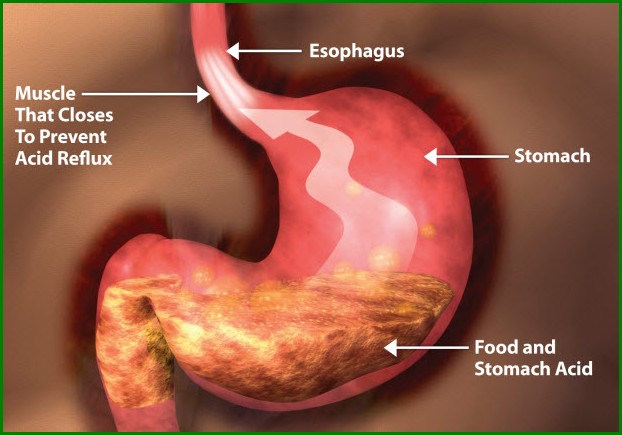Gastoezofagalnaya Reflux Disease Gastroesophageal reflux disease (GERD) - a chronic disease caused by lack of anti-reflux barrier with non-physiological reflux of gastric contents into the cardia (distal) esophagus and subsequent damage to its mucosa with the development of the inflammatory process.

Local factors of GERD.
The first mention of heartburn and acid regurgitation is found in the writings of Avicenna (X-XI centuries).
The first description of gastroesophageal reflux disease in 1879 introduced H.Quinke.
In 1995, the adoption of the first Guidelines for the diagnosis and treatment of gastroesophageal reflux disease (American College of Gastroenterology), updated in 1999 and 2005.
Official recognition of GERD as an independent nosological entity in October 1997 at the Forum in gastroenterology Genval (Belgium).
Epidemiology
There are no reliable data on the incidence of GERD is not. It is believed that about 30% of the adult population have different manifestations of GERD. Thus, more than 61 million Americans celebrate heartburn at least 1 time per month and 18 million point to problems with the assimilation of food, including heartburn at least twice a week.
Risk factors, etiology, pathogenesis
The main risk factors are smoking, overweight, regular overeating, pregnancy, abuse of hot, spicy, fatty, fried foods, sweets, fizzy drinks, alcohol, strong coffee and tea, as well as medication, relaxing the lower esophageal sphincter (nitrates, calcium channel blockers, etc.), connective tissue dysplasia, a genetic predisposition.
By the development of GERD cause dysfunction of the lower esophageal sphincter (LES), impaired motor function of the esophagus and hiatal hernia. The value also belongs to the lower esophageal clearance of the esophageal mucosa, the aggressiveness of the gastric juice, disruption of evacuation from the stomach, increased intra-abdominal pressure, frequency and duration of reflux episodes. Pathological reflux occurs when reducing the basal pressure in the lower esophageal sphincter is less than 2 mm Hg. Art.
In all these processes the importance belongs disturbances in the autonomic nervous system of regulation of the NAP.
GERD attributed to acid disorders, considering. hydrochloric acid, rather, gastric juice, one of the pathogenic factors leading it from damage to the esophageal mucosa development and its supporting wall chronic inflammation.
The significance of infection Helicobacter pylori (HP) in GERD, but the available data are still controversial.
Classification
Clinical forms:
• non-erosive reflux disease without endoscopically detectable mucosal changes of the esophagus cardiac syndromes of heartburn and / or discomfort in the chest and other clinical manifestations of not less than 3 months
• erosive esophagitis with endoscopically detectable erosive damage to the mucosa of the esophagus at the cardiac portion of the associated syndromes.
Endoscopic stage of erosive esophagitis in Los Angeles classification:
A - one or more of the esophageal mucosa damage, not exceeding 5 mm and not more exciting than the one its fold
B - one or more esophageal mucosal injury than 5 mm and not more than exciting one of its fold
C - one or more damage esophageal mucosa, exciting more than one single fold but not more than 75% of its circumference
D - povrezhdeniyaslizistoy esophagus, exciting more than 75% of its circumference.
Endoscopic classification of severity of esophagitis by Savary-Miller:
I - the individual is not confluent erosions and / or erythema of the distal esophagus
II - confluent, but not spectacular most of the mucosal erosion
III - erosive lesions of the lower third of the esophagus, merging and covering the entire surface of the lining of the esophagus
IV - a chronic ulcer of the esophagus, the cylindrical (gastric or intestinal) metaplasia of the lining of the esophagus (Barrett's esophagus).
The clinical picture
Clinical manifestations of GERD is divided into esophageal and vnepischvodnye.
For oesophageal include heartburn, regurgitation, dysphagia, odynophagia, chest pain, and to extraesophageal - cough, dyspnea, hoarseness, unpleasant sensation in the throat, episodes of sleep apnea, ear pain, bad breath or halitosis, tooth enamel damage and perversion of taste or dysgeusia.
Heartburn occurs in 83% of patients. Its amplification occurs when a heavy meal, torso, errors in diet, taking carbonated drinks, the concentration of hydrochloric acid in reflyuktata and duration of its contact with the mucosa of the esophagus. In 10% of GERD occurs only pain in the chest by the type of angina.
Complications of GERD include peptic ulcers, structure, or narrowing of the esophagus, Barrett's esophagus, esophageal bleeding and adenocarcinoma.
Under Barrett's metaplasia of the gastric mucosa understand the esophagus proximal to 2.5 cm from the gastroesophageal junction, due to which it belongs to the precancerous diseases. The risk of developing adenocarcinoma of these patients increases in 30-125 times.
Diagnosis and differential diagnosis
Though the diagnosis is based on data from interviews, objective, laboratory and functional studies, it is critical to have it last.
The primary method of diagnosis is the esophagogastroduodenoscopy that complications of GERD (ulceration, Barrett's esophagus, etc.) supplemented by biopsy.
When endoscopically negative form of GERD performed 24-hour intraesophageal pH-metry, which allows to differentiate it from other nature pain in the chest and coughing. In a study of the pH probe in the esophagus is set to 5 cm above the upper limit of the NAP. Under physiological conditions, the esophagus pH 6-7, and gastric content is reduced to 4 or less.
PH levels below 4 is considered to be evidence of gastroesophageal acid reflux.
Heartburn, Acid Reflux, GERD-Mayo Clinic
Many people have symptoms of Gastroesophageal Reflux Disease, or GERD, often called acid reflux. This video shows how the esophagus works and how acid can splash into the esophagus because of a hiatal hernia or weakness of the valve called the lower esophageal sphincter. Mayo Clinic has a very large team with an international reputation for its skill in diagnosing and treating reflux, Barretts esophagus and esophagus cancer. For more information, go to the Mayo Clinic website, http://www.mayoclinic.org/barretts-es...